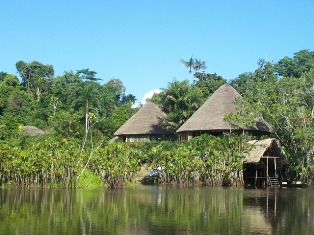Unit 14 Introduction
Reading: Chapter 15 in Macionis, pp. 449 - 479
In Unit 14 we look at social change. Over the past 13 weeks we have examined the structure of society, but social structures are not static. They change in response to other changes in the social and natural environment. We consider an important factor that motivates social change, population change, and we consider an important ramification of social change, environmental deterioration.
 Fig. 14-1: Sani Lodge and Tropical Rainforest, Challuacocha, Amazonas, Ecuador |
Throughout most of human history, the number of humans on the planet increased very slowly. At the dawn of the industrial era, around 1750, the global population numbered about 750 million. Today, the figure is 6.8 billion and growing. World population surpassed 6 billion in 1999 and is projected to reach 7 billion in 2011. Virtually all of this growth is in the developing countries of Africa, Asia and Latin America.
Why has the population grown so quickly in the past 250 years? Social structures and cultural norms play an important role in this phenomenon. What have been some of the effects of rapid population growth? Some of the most vexing problems have been the effects of an overcrowded planet on our environment -- the resources that we rely on to sustain life. As population grows and as people get wealthier and therefore demand more resources, we are shrinking our supplies of wood, minerals and food to points that are not sustainable. As we use these resources to manufacture products, we produce waste products, but do not have reliable means of disposing of this waste. The waste ends up polluting our water, air and land -- the very resources we rely upon the most!
In Unit 14 you will learn about some of the measures that demographers use to study changes in the human population, and some of the explanations they have come up with to help us understand population growth. Some of these changes will have profound effects on your lives. As the number of people grows in the Global South, and as more and more of them move into the middle class, the current world system of power and resource distribution will likely shift. The road to change will not be smooth, however, and may lead to substantial violence as groups fight over limited resources. Additional problems will arise from global warming, air and water pollution, depletion of rainforests and other important reserves of biological diversity, overfishing and pollution in the oceans, and other emerging global environmetnal issues. The next generation has many challenges to face, and part of the solutions lie in finding institutions that can solve the problems without exacting too much harm on the world's population.
GO TO WEEK 14 GOALS AND OBJECTIVES>>>